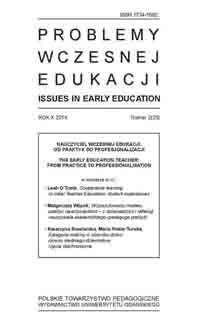Metoda projektów jako strategia wcielania w praktykę idei wyłaniającego się programu
Słowa kluczowe:
program nauczania, metoda projektów, Reggio EmiliaAbstrakt
The paper presents the idea of a project method which is interpreted from the perspective of two approaches to the curriculum. The first one defines the curriculum as a product – a plan with general and specific educational objectives which are set up in advance. From this point of view the curriculum is a set of documents for implementation. Another way of looking at the curriculum is via process. In this sense, the curriculum is not a physical thing, but is interpreted as what actually happens in an educational environment. In an emergent curriculum, instead of general and specific objectives, teachers formulate hypotheses derived from children’s personal experiences. Along with these hypotheses teachers formulate objectives which are flexible and correspond to the needs and interests of their students. The process of emergent curriculum development is described on the basis of the Italian strategy progettazione and the project approach by L. Katz.Downloads
Bibliografia
Dahlberg G., Moss P., Pence A. (2013), Poza dyskursem jakości w instytucjach wczesnej edukacjii opieki. Wrocław, Wydawnictwo Naukowe DSW.
Dylak S. (1999), Wprowadzenie do konstruowania szkolnych programów nauczania. Warszawa,Wydawnictwa Szkolne PWN.
Ekiert-Oldroyd D. (2006), Zmiany edukacyjne w oświacie. Od paradygmatu zmiany do zmiany paradygmatu.„Chowanna”, 1 (26).
Forman G., Fyfe B. (2012), Negotiated Learning through Design, Documentation and Discourse. W: C. Edwards, G. Forman, L. Gandini (red.), The Hundred Languages of Children. The ReggioEmilia Experience in Transformation. Santa Barbara, Praeger.
Fullan M.G., Miles M.B. (1992), Getting Reform Right: What Works and What Doesn’t. “Phi DeltaKappan” 73.
Gandini L. (2012), History, Ideas, and Basic Principles: An interview with Loris Malaguzzi. W:C. Edwards, G. Forman, L. Gandini (red.), The Hundred Languages of Children. The ReggioEmilia Experience in Transformation. Santa Barbara, Praeger.
Gołębniak B.D. (2004), Nauczanie jako negocjowanie szkolnego programu nauczania. W: B.D. Gołębniak(red.), Uczenie metodą projektów. Warszawa, WSiP.
Gołębniak B.D. (2006), Program szkolny. W: Z. Kwieciński, B. Śliwerski (red.), Pedagogika T. 2. Warszawa, PWN.
Helm J.H., Beneke S. (red.) (2003), The Power of Project. Meeting Contemporary Challenges inEarly Childhood Classrooms – Strategies & Solution. New York, Teachers College Press.
Helm J.H., Katz L.G. (2003), Mali badacze. Metoda projektu w edukacji elementarnej. Warszawa,CODN.
Jones E., Nimmo J. (1995), Emergent Curriculum. Washington, NAEYC.
Karczewska-Gzik A. (red.) (2009), Metoda projektu w praktyce oddziału przedszkolnego w szkole. Warszawa.
Katz L., Chard S. (2000), Engaging Children’s Minds: The Project Approach. Atamford, Alex PublishingCorporation.
Klus-Stańska D. (2006), Behawiorystyczne źródła myślenia o nauczaniu, czyli siedem grzechówgłównych wczesnej edukacji. W: D. Klus-Stańska, E. Szatan, D. Bronk (red.), Wczesna edukacja. Między schematem a poszukiwaniem nowych ujęć teoretyczno-badawczych. Gdańsk, Wydawnictwo UG.
Klus-Stańska D. (2010), Dydaktyka chaosu pojęć i zdarzeń. Warszawa, Wydawnictwo Akademickie„Żak”.
Klus-Stańska D., Nowicka M. (2005), Sensy i bezsensy edukacji wczesnoszkolnej. Warszawa, WSiP.
Maj A. (2013), Dokumentowanie procesu edukacyjnego jako fundament pracy nauczyciela wczesnejedukacji – z doświadczeń nauczycieli przedszkoli w Reggio Emilia we Włoszech. W: J. Bonar,A. Buła (red.), Poznać. Zrozumieć. Doświadczyć. Konstruowanie wiedzy nauczyciela wczesnejedukacji. Kraków, Impuls.
Malaguzzi L. (1994), Your image of the child: where teaching begins. “Care Information Exchange”,96.
Malaguzzi L. (2012), History, Ideas, and Basic Philosophy: An interwiev with Lella Gandini byLoris Malaguzzi, [w:] W: C. Edwards, G. Forman, L. Gandini (red.), The Hundred Languages ofChildren. The Reggio Emilia Experience in Transformation. Santa Barbara, Praeger.
Ornstein A.C., Hunkins F.P. (1999), Program szkolny. Założenia, zasady, problematyka. Warszawa,WSiP.
Rankin B. (1998), Curriculum Development in Reggio Emilia: A Long-Term Curriculum. Projectabout Dinosaurs. W: C. Edwards, L. Gandini, G. Forman (red.), The Hundred Languages ofChildren: The Reggio Emilia Approach – Advanced Reflection. Norwood, Ablex Publishing.
Rinaldi C. (2006), In Dialogue with Reggio Emilia. Listening, Researching and Learning. London,Routledge.
Rinaldi C. (2008), Documentation and Assessment: What Is the Relationship? W: C. Giudici,M. Krechevsky, C. Rinaldi (red.) Making Learning Visible: Children as Individual and GroupLearners, Reggio Emilia, Reggio Children.
Rinaldi C.(2012), The Pedagogy of Listening: The Listening Perspective from Reggio Emilia. W:C. Edwards, G. Forman, L. Gandini (red.), The Hundred Languages of Children. The ReggioEmilia Experience in Transformation. Santa Barbara, Praeger.
Szymański M.S. (2010), O metodzie projektów. Warszawa, Wydawnictwo Akademickie „Żak”.
Vecchi V. (2010), Art and Creativity in Reggio Emilia. Exploring the role and potential of ateliers inearly childhood education, London, Routledge.
Zwierżdżyński M.K. (2012), Konstruktywizm a konstrukcjonizm. „Prinzipia”, LVI.

 Uniwersyteckie Czasopisma Naukowe
Uniwersyteckie Czasopisma Naukowe





